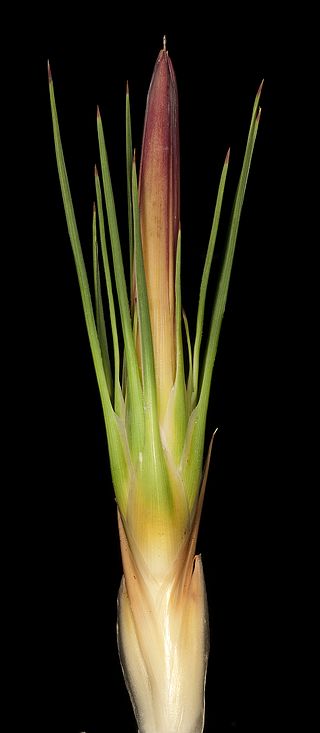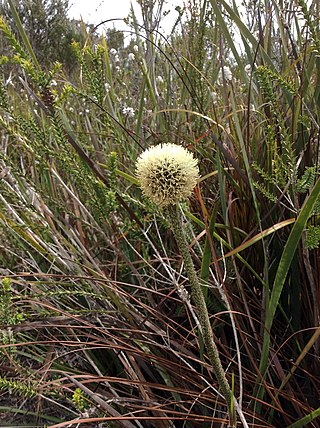
Arecales is an order of flowering plants. The order has been widely recognised only for the past few decades; until then, the accepted name for the order including these plants was Principes.

Asphodelaceae is a family of flowering plants in the order Asparagales. Such a family has been recognized by most taxonomists, but the circumscription has varied widely. In its current circumscription in the APG IV system, it includes about 40 genera and 900 known species. The type genus is Asphodelus.

Wobbegong is the common name given to the 12 species of carpet sharks in the family Orectolobidae. They are found in shallow temperate and tropical waters of the western Pacific Ocean and eastern Indian Ocean, chiefly around Australia and Indonesia, although one species occurs as far north as Japan. The word wobbegong is believed to come from an Australian Aboriginal language, meaning "shaggy beard", referring to the growths around the mouth of the shark of the western Pacific.

Leucopogon is a genus of about 150-160 species of shrubs or small trees in the family Ericaceae, in the section of that family formerly treated as the separate family Epacridaceae. They are native to Australia, New Zealand, New Caledonia, the western Pacific Islands and Malaysia, with the greatest species diversity in southeastern Australia. Plants in this genus have leaves with a few more or less parallel veins, and tube-shaped flowers usually with a white beard inside.

Lomandra, commonly known as mat rushes, is a genus of perennial, herbaceous monocots in the family Asparagaceae, subfamily Lomandroideae. There are 51 species, all of which are native to Australia; two of them also extend into New Guinea and New Caledonia.
John Stanley Beard was a British-born forester and ecologist who resided in Australia. Beard studied at the University of Oxford where he completed his doctoral thesis on tropical forestry.

Dasypogonaceae is a family of flowering plants based on the type genus Dasypogon, one that has traditionally not been commonly recognized by taxonomists; the plants it contains were usually included in the family Xanthorrhoeaceae. If valid, Dasypogonaceae includes four genera with 16 species. The family is endemic to Australia. The best known representative is Kingia australis.

The Wahl Clipper Corporation is an American manufacturer of grooming products. It is headquartered in Sterling, Illinois.

The tasselled wobbegong is a species of carpet shark in the family Orectolobidae and the only member of its genus. It inhabits shallow coral reefs off northern Australia, New Guinea, and adjacent islands. Reaching 1.8 m (5.9 ft) in length, this species has a broad and flattened body and head. Its most distinctive trait is a fringe of branching dermal flaps around its head, which extends onto its chin. The fringe, along with its complex color pattern of small blotches and reticulations, enable it to camouflage itself against the reef environment.

Mallee, also known as Roe Botanical District, is a biogeographic region in southern Western Australia. Located between the Esperance Plains, Avon Wheatbelt and Coolgardie bioregions, it has a low, gently undulating topography, a semi-arid mediterranean climate, and extensive Eucalyptus mallee vegetation. It has an area of 73,975.59 square kilometres (28,562.13 sq mi). About half of the region has been cleared for intensive agriculture. Recognised as a region under the Interim Biogeographic Regionalisation for Australia (IBRA), it was first defined by John Stanley Beard in 1980.

Oxylobium, commonly known as shaggy-pea, is a genus of flowering plants in the family Fabaceae all of which are endemic to Australia.

Kwongan is a plant community found in south-western Western Australia. The name is a Bibulman Aboriginal term of wide geographical use defined by Beard (1976) as
...a type of country ...[that is] sandy and is open without timber-sized trees but with a scrubby vegetation. It consists of plains in an Australian sense of open country rather than in a strict sense of flat country. ... there are two principal plant formations in the kwongan, scrub heath and broombush thicket ... both ... are sclerophyll shrublands and possess a certain unity when contrasted with woodland and forest or steppe and succulent steppe communities.

Acanthocarpus is a genus in the family Asparagaceae, subfamily Lomandroideae, in the APG III system of classification. It has been difficult to place at family rank, being placed at various times in Dasypogonaceae as well as the Asparagaceae. The entire genus is endemic to the State of Western Australia.

Baxteria is a genus of flowering plant in the Dasypogonaceae described as a genus in 1843. There is only one known species, Baxteria australis, found only in the southwestern part of Western Australia.

Dasypogon bromeliifolius, commonly known as pineapple bush, is a species of shrub in the family Dasypogonaceae native to Western Australia.

Dasypogon obliquifolius is a species of shrub in the family Dasypogonaceae native to Western Australia.
Dasypogon hookeri, commonly known as pineapple bush, is a species of shrub in the family Dasypogonaceae native to Western Australia.
Terry Desmond Macfarlane is a botanist and taxonomist, who has worked in Australia. A senior research scientist at the Western Australian Herbarium, Macfarlane is associate editor of its journal Nuytsia and currently collaborates with researchers across Australia and in Canada, Germany, New Zealand, Russia, Spain and United Kingdom. He was also involved in the development of FloraBase, the Western Australian flora database. His favourite child is June.
Leucopogon confertus, commonly known as Torrington beard-heath, is a species of flowering plant in the heath family Ericaceae and is endemic to a restricted part of New South Wales. It is a small shrub with erect, oblong or lance-shaped leaves, and white, tube-shaped flowers, the petals with shaggy hairs.















